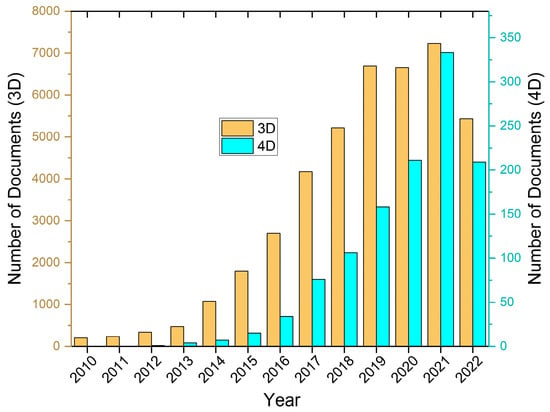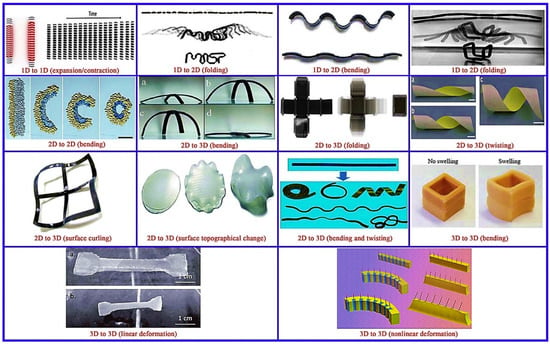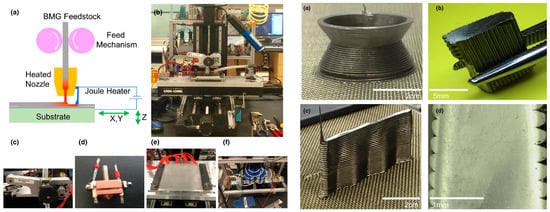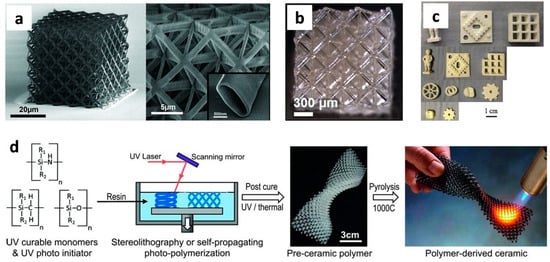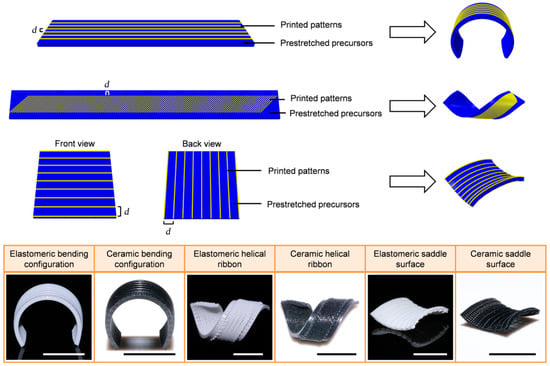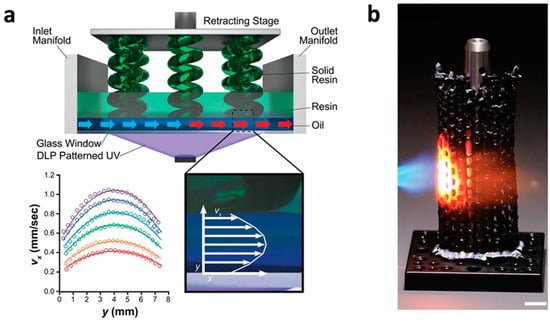2. Three-Dimensional/Four-Dimensional Printing Process and Materials
2.1. General Process
The main printing process is often the same regardless of the method that a 3D/4D printer employs to create objects. The main steps involved in any AM printing technology are briefly described below [
15]. The steps are as follows:
-
Computer-aided Design (CAD): CAD software creates a three-dimensional model of the object. Using scientific data on the particular materials, the program may produce virtual simulations of how the thing would perform under various circumstances. The CAD model is next converted into Standard Tessellation Language (STL) conversion. STL is a file format that was designed for 3D systems in 1987 by their stereolithography apparatus (SLA) machines. STL files are supported by almost all 3D printers.
-
STL file manipulation and the transfer to machines: the STL file is then copied by the user to the computer that manages the 3D printer. There, the user may choose the printing’s size and direction. This is comparable to setting up a usual paper printer to print on both sides or in landscape rather than the portrait orientation.
-
The next step is to set up the machine. Each machine has specific guidelines for getting ready for a fresh print job. This entails restocking the printer’s polymers, binders, and other consumables.
-
Building process: at this point, you may sit back and relax, as the majority of the building process is handled automatically. Although it may be considerably thinner or thicker, each layer is typically 0.1 mm thick. This procedure might take hours or even days to complete, depending on the size of the item, the machine, and the materials utilized.
-
Post-processing: the printed object from many 3D printers will need some post-processing finishing. This can include washing the printed item to get rid of any residual powder or brushing off any water-soluble supports. Since certain materials require time to cure at this stage, the printed structure could be fragile, thus care may be needed to prevent it from breaking or disintegrating. Applications are the next steps, where printed structures/objects are installed and put to use.
The need to print intricate structures at a high resolution has fueled the development of additive manufacturing (AM) techniques. One of the main reasons for the development of AM technologies is the capacity to print massive structures, reduce printing flaws, and improve mechanical qualities. Fused deposition modeling (FDM) is the most popular 3D printing technique that primarily makes use of polymer filaments. The primary techniques for additive manufacturing (AM) include inkjet printing (IP), contour crafting, stereolithography (SLA), direct energy deposition (DED), laminated object manufacturing (LOM), selective laser sintering (SLS), selective laser melting (SLM), and liquid binding in 3D printing. These techniques are briefly defined, their uses and appropriate materials, and their advantages and disadvantages are presented in
Table 1. In Bhushan and Caspers's book [
51], these techniques are covered in great detail. Mao et al. [
52] presented novel developing techniques for particular applications, such as two-photon polymerization (TPP), projection micro stereolithography (PSLA), and electrohydrodynamic printing (EHDP), while Changhai et al. [
53] described the non-contact micro- and nano-printing techniques.
Table 1. A comparison of additive manufacturing printing processes, materials used, applications, and pros and cons. Table adapted from [
63,
64].
To create consistently high-quality products, 3D printing requires high-quality materials that adhere to strict requirements, much like any other manufacturing process. The procedures, requirements, and agreements about material controls are established between the suppliers, buyers, and end-users of the material in order to achieve this. Using a variety of materials, such as ceramics, metals, polymers, and their mixtures to create hybrid, composite, or functionally graded materials, 3D printing technology may create completely functioning components (FGMs). A comparison of the different 3D/4D printing technologies is presented in
Table 1. As described earlier, a 4D printed object undergoes a shape transformation or change in the property when it is subjected to external stimuli such as water [
24,
25], light [
26,
27], heat [
28,
29], pH [
30], electricity, magnetic fields, and so on [
31,
32,
33,
34]. The change in shape that may occur can be from 1/2/3D to 1/2/3D [
54]. The examples of the shape transformations are shown in
Figure 3.
Figure 3. Various examples of different kinds of shape responses 1D to 1D (expansion and contraction) [
25], 1D to 2D (folding and bending), 1D to 3D (folding) [
55], 2D to 2D (bending) [
56], 2D to 3D (bending) [
57], 2D to 3D (folding) [
55], 2D to 3D (twisting) [
58], 2D to 3D (surface curling), 2D to 3D (surface topographical change) [
55], 2D to 3D (bending and twisting) [
59], 3D to 3D bending [
60], 3D to 3D linear deformation [
61], 3D to 3D nonlinear deformation [
27]. Figures reproduced with permissions from [
27,
55,
56,
57,
58,
59,
60,
61,
62].
2.2. Materials for 3D/4D Printing
Materials for additive manufacturing fall into three categories: polymers, ceramics, and metals. Polymers are the most regularly used and available materials, however, as technology advances, additional materials are being produced. Typically, materials are manufactured as wire feedstock or powders, however, this is diversifying over time. Due to the simplicity of producing and handling polymeric materials, 3D printing has traditionally concentrated on polymers for printing. However, the process has swiftly progressed to print not only diverse polymers but also metals and ceramics, making 3D printing a flexible production alternative. The primary uses, advantages, and difficulties of the primary materials for additive manufacturing are summarized in Table 2.
Table 2. A comparison of the materials used in 3D/4D printing, their applications, benefits, and challenges [
64].
| Materials |
Main Applications |
Benefits |
Challenges |
| Metals and alloys |
Aerospace and Automotive
Military
Biomedical |
Multifunctional optimization
Mass-customization
Reduced material waste
Fewer assembly components
Possibility to repair damaged or worn metal parts |
Limited selection of alloys
Dimensional inaccuracy and poor surface finish
Post-processing may be required (machining, heat treatment or chemical etching) |
| Polymers and composites |
Aerospace and Automotive
Sports
Medical
Architecture
Toys
Biomedical |
Fast prototyping
Cost-effective
Complex structures
Mass-customisation |
Weak mechanical properties
Limited selection of polymers and reinforcements
Anisotropic mechanical properties (especially in fibre-reinforced composites) |
| Ceramics |
Biomedical
Aerospace and Automotive
Chemical industries |
Controlling porosity of lattices
Printing complex structures and scaffolds for human body organs
Reduced fabrication time
A better control on composition and microstructure |
Limited selection of 3D-printable ceramics
Dimensional inaccuracy and poor surface finish
Post-processing (e.g., sintering) may be required |
| Concrete |
Infrastructure and construction |
Mass-customization
No need for formwork
Less labour required especially useful in harsh environment and for space construction |
Layer-by-layer appearance
Anisotropic mechanical properties
Poor inter-layer adhesion
Difficulties in upscaling to larger buildings
Limited number of printing methods and tailored concrete mixture design |
2.2.1. Polymers
Due to their versatility and adaptability to various 3D printing techniques, polymers are regarded as the most widely used materials in the 3D printing industry. Thermoplastic filaments, reactive monomers, resin, and powder are the most common forms of polymers used in additive manufacturing. For many years, the 3D printing of polymers and composites has been investigated in a variety of industrial applications, including the aerospace, architectural, toy manufacturing, and medical industries.
In stereolithography 3D printing, photopolymer resins may polymerize when triggered by UV light. According to Wohlers Associates’ annual industry study, photopolymer-generated prototypes account for close to 50% of the 3D printing market in the industrial sectors [
5,
65]. The thermomechanical characteristics of photopolymers need still be enhanced, however, for instance, due to the gradient in UV exposure and intensity, the molecular structure and alignment of 3D-printed polymers depend on the layer thickness [
66,
67].
There are several ways to produce polymer composites, including stereolithography, ink-jet 3D printing, selective laser sintering, and deposition molding [
68]. Other approaches are either currently being researched and developed or are being used by scientists. Each method has pros and cons when it comes to the creation of polymer composite goods. The requirements for raw materials, processing speed and accuracy, cost, and product performance standards may all have an impact on the manufacturing process.
Figure 4 displays the various available polymer 3D printing technologies.
Figure 4. Various 3D printing technologies for polymer materials. Figure reproduced from [
9].
Polydimethylsiloxane, also known as PDMS, is the most common kind of polymer used in silicone systems [
69]. This is due to the material’s superior mechanical flexibility and stretchability, chemical inertness, biocompatibility, and high thermal stability when compared to other types of elastomers. In addition, PDMS maintains a significant degree of chemical stability even when subjected to high temperatures and pressures [
70].
Thermosetting polymers go through chemical reactions throughout the formation process to create cross-linked structures, which harden after curing and do not melt when heated again. The thermosetting polymers can no longer soften when heated a second time because of this irreversible alteration. Phenolic plastics, amino plastics, epoxy plastics, unsaturated polyester plastics, organosilicon plastics, and polymethylmethacrylate (PMMA) are the principal types of thermosetting plastics [
71,
72].
The combination of nanoparticles with polymer materials may result in the production of high-performance functional composites. Lin et al. [
73] demonstrated that the graphene oxide/photopolymer composite that was generated by SLA has both high levels of strength and ductility.
Nylon, polycarbonate, ABS (acrylonitrile butadiene styrene), and PLA (polylactide) including soft PLA, as well as recyclable alternatives, are all common polymers that may be used in 3D printing. Polymers like these are commonly utilized in material extrusion printers and are spread in wire feedstock. A number of approaches involve combining powdered polymers in varied amounts to achieve distinct aesthetic and structural effects. Waxes and epoxy-based resins are also often utilized.
Polymer additive manufacturing (PAM) may be used to produce delicate and complicated structures for the aerospace industry, structural models for the building industry, art replicas that are not real, and tissue and organs for use in medicine. However, the majority of AM polymer products are still employed as samples rather than practical components since they lack the strength and essential functionality of pure polymer products. The widespread industrial use of polymer AM is constrained by these drawbacks. Polymer matrix composites have been created by adding particles, fibers, or nanomaterial reinforcements to the polymer to address these drawbacks.
2.2.2. Metallic Materials
Metals are employed in 3D printing complex electrical and circuitry components, as well as the structural and mechanical elements and integral functioning components. High-temperature processes can deposit them in liquid form, or they can be sintered or melted from powder. Steel, gold, silver, aluminum, cobalt-chrome alloy, titanium, and stainless steel are common metals used in 3D printing.
The process of 3D printing metals often begins with the melting of metallic feedstock, which can be either in the form of a powder or solid, with the use of an energy source such as a laser or an electron beam. The material that has been melted undergoes a transformation on a layer-by-layer basis to produce a solid component. Powder bed fusion (PBF) and direct energy deposition (DED) are the two methods that are most often used for the process of printing metals. PBF-based additive manufacturing procedures are capable of producing a wide variety of metallic materials, including stainless and tool steels, some aluminum alloys, titanium and its alloys, and nickel-based alloys, amongst others [
74]. PBF technology can produce parts with excellent mechanical characteristics and intricate forms with a great precision.
AM has been optimized for titanium and its alloys, steel alloys, a few aluminum alloys, nickel alloys, and a few magnesium and cobalt-based alloys [
74]. Particularly high-performance materials that are often utilized in a variety of sectors include titanium and its alloys [
75,
76]. They are distinguished by expensive machining and a lengthy lead time based on traditional production techniques. The ability of AM to produce very complex structures at reduced prices and with less waste may therefore result in major economic benefits. Materials such as austenitic stainless steels [
77], maraging steels [
78], precipitation-hardenable stainless steels [
79], and tool steels [
80] are often employed. In addition to the typical uses, these alloys may be utilized in situations requiring great strength and hardness, such as in the manufacturing of tools or molds.
For a variety of reasons, only a few Al alloys are presently utilized in AM. They are less expensive and easier to process than Ti alloys [
81]. As a result, their usage in AM has drawn little commercial attention. This is mainly due to the reason that Al alone has a high reflectivity for the laser wavelengths often employed in AM [
81], and certain high-performance Al alloys are rarely weldable because of the high volatility of some of its constituents, such as Zn [
82].
Due to their randomly arranged atoms, metallic glasses (MGs) exhibit a wide range of intrinsic features, such as catalytic [
83,
84,
85,
86], soft magnetic [
87,
88], corrosion resistance [
89], and excellent mechanical [
90] capabilities. The majority of AM manufacturing processes include heating and cooling. The metallic glass starts to crystallize once it reaches the temperature for crystallization [
91]. Both MGs and MG composites may be produced additively with a variety of characteristics for diverse purposes. Bulk metallic glasses (BMGs), in contrast to typical metals, exhibit a supercooled liquid zone and continuous softening upon heating, similar to thermoplastics. Gibson et al. [
92] demonstrated that, by extending this analogy, BMGs may also be created via fused filament extrusion (FFF) in 3D printing. The supercooled liquid nature of the BMGs enables 3D printing under circumstances comparable to thermoplastics. In ambient environmental conditions, fully dense and amorphous BMG parts can be 3D printed which possess high strength as shown in
Figure 5.
Figure 5. Example of metallic glass printing. The schematic and physical setup of the fused filament fabrication (FFF) process for direct-write extrusion of bulk metallic glasses (
a–
d, left): (
a) schematic, (
b) physical setup, (
c) feed mechanism, (
d) extrusion nozzle, (
e) heated substrate stage, and (
f) capacitor bank that generates the applied voltage. The printed bulk metallic glass products (
a–
d, right): (
a) continuous, (
b) start-stop printing of BMG, (
c) printed fully dense and pore-free parts, and (
d) zoom in view of (
c). Figures reproduced from [
92].
The production of complicated components built using expensive materials, such as titanium and its alloys, which are crucial for the aerospace and healthcare sectors, is made easier by additive manufacturing of metals. Metal additive manufacturing is a constantly expanding field, with new techniques, alloys, and applications being revealed increasingly on a regular basis. This leads to notable quality gains and faster production times.
2.2.3. Ceramics
Typically, ceramics are utilized in powder-based additive manufacturing processes. Ceramic fibers are primarily made of silica and glass, porcelain, and silicon-carbide, and they can be coupled with polymer or metal substrate materials to boost their strength. A high mechanical strength and hardness, good thermal and chemical stability, and viable thermal, optical, electrical, and magnetic performance are some of the properties that make them such versatile materials for 3D printing. Ceramic components are typically formed into the desired shapes from a powder mixture with or without binders and other additives.
Ceramics printing based on powder/slurry. In comparison to polymers and metals, the AM of ceramics is difficult, owing to the exceptionally high melting temperatures of ceramic materials [
93] and the difficult preparation of feedstocks [
94].
Figure 6 depicts several common ceramic 3D printing procedures. Various AM techniques, such as SLS [
95], selective laser burn-out [
96], stereolithography (SLA) [
97], projection micro-stereolithography (PµSL) [
98], laminated object manufacturing (LOM) [
99], DIW [
100], IP [
101], FDM [
102], and digital light processing (DLP) [
103], are commonly used to create ceramic structures from powders or slurries. Because of the significant heat gradients, many of these ceramic printing processes suffer from inescapable residual porosities and undesired fissures, resulting in poor mechanical behaviors of the manufactured ceramic structures.
Figure 6. Examples of some common 3D printing procedures for ceramics. Small-scale ceramics may be 3D printed using coating-film-based ceramic printing feedstocks. (
a,
b): (
a) an Al
2O
3 nanolattice with hollow tubes [
104]. (
b) Al
2O
3 hollow-tube micro-lattice [
98]. (
c,
d) Large-scale ceramics printed in 3D: (
c) selective laser sintering [
95] and (
d) stereolithography (SLA)/self-propagating photopolymer wave-guide technique for ceramics generated from polymers [
93].
Coating film-based ceramics. The invention of atomic layer deposition made it possible to cover TiN or Al
2O
3 on 3D printed polymer templates to create hollow ceramic nanolattices [
98,
104,
105] or a ceramic composite microarchitecture [
106]. After coating the ceramic sheets, the polymer template can be removed to reveal the delicate nano-/micro-structures. The microscale size of the created structures and the method’s poor manufacturing speeds, however, significantly restrict its use.
Polymeric precursor-based ceramics. Significant advancements in ceramic processing have been made possible by the AM of preceramic polymers. With just a slight and consistent shrinkage, printed polymers may be transformed in situ to ceramics, yielding intricate and exact ceramic constructions. Additionally, because pyrolysis temperatures are substantially lower than sintering temperatures, this operation uses a lot less energy than traditional powder or slurry sintering processes.
A revolutionary technique for creating highly shaped ceramic structures is the AM of ceramic precursors. For the last 50 years, polymer-derived ceramics (PDCs), created by the in situ thermolysis of preceramic polymers, have permitted enormous scientific advancements in the field of ceramics [
94,
107]. For a variety of structural and functional applications, PDCs have shown to be promising material choices [
108,
109].
One of the most promising preceramic precursors is silicon-containing polymers, which often include multinary ceramics like SiCNO [
110,
111] or ternary ceramics like SiOC [
112,
113] and SiCN [
113,
114]. PDC nanocomposites may be created by adding different kinds of nanofillers to preceramic polymers before machining, such as ceramics [
112], metals [
115], or polymers. These nanofillers can build jammed network structures in the preceramic polymer matrix to improve the mechanical integrity of the finished ceramics [
116] and act as barriers to mass and heat transmission, reducing shrinkage during ceramization [
107].
Liu et al. [
117] developed the first 4D printing ceramic, i.e., elastomeric poly(dimethylsiloxane) matrix nanocomposites (NCs) that are capable of being printed, deformed, and then changed into silicon oxycarbide matrix NCs, hence allowing the creation of intricate ceramic origami and 4D-printed ceramic structures, achievable as seen in
Figure 7. By releasing the elastic energy trapped in the pre-strained ceramic precursors, which could be stretched to over a 200% strain, a shape-morphing process could be accomplished [
117]. The above-mentioned research on elastomer-derived ceramics (EDCs) may provide new methods for creating soft/rigid hybrid structural materials, which may lead to innovation for the use of ceramic precursor/ceramic hybrid systems in a variety of fields, such as bio-implants and bio-inspired structures [
118].
Figure 7. Four-dimensional printing of elastomer-derived ceramics (EDCs) and origami. Two typical ceramic 4D printing processes (scalebars: 1 cm). Figure reproduced with permission from [
117].
PDCs and EDCs will play an increasingly essential role in the additive manufacturing of ceramic structures in future research. Ceramic 3D printing is going to grow bigger and quicker as new printing material systems, printing methods, and post-processing techniques are developed as per a study presented in
Figure 8 [
41]. Ceramic 4D printing will make use of novel material systems, such as those with shape-memory properties, in order to become more adaptable, precise, and applicable.
Figure 8. Examples of 3D printed polymer-based ceramics (PDCs). (
a) High-area rapid printing (HARP) process diagram (
b) HARP approach for the large-scale polymer-based SiC structures [
41].

